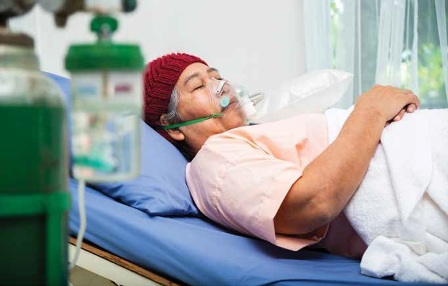It is evident today that the landscape for cancer care is undergoing a dynamic change. Services and technologies like diagnostic imaging, oncology drug administration and radiation therapy have made outpatient care accessible to cancer patients. As the cancer burden in Asia continues to increase, outpatient integrated cancer centres are efficient model to serve the needs of cancer patients.
Cancer is the second leading cause of death globally, and accounts for nearly 5.2 million lives in Asia according to a report in 2018. This indicates that there is a pressing need to provide good quality cancer care in Asia. The question is, what is good quality cancer care in an Asian context?

Cancer is a complicated disease by nature. It represents a large number of diseases in different organs with malignant cells dividing uncontrollably and potentially spreading to other organs. Cancer patients can be diagnosed at different stages of disease or at different organs. Some patients may discover the disease at health screening or from cancer symptoms. After the initial diagnosis, cancer can be treated with surgery, chemotherapy, radiation therapy. The whole process can take at least 6 to 12 months. After active treatment, the recovery process can be even longer. Therefore, cancer care that is tailored to the lifestyle and cultural context of cancer patients should be the way to go.
Cancer care encompasses a wide range of medical services, including diagnostics procedures, pathology tests, imaging, surgery, radiation therapy, intravenous drug administration, oral drugs and supportive treatment. Due to the complexity of some of the procedures, patients will have to be admitted to the hospitals. For example, if a pancreatic cancer patient needs to have Whipple's operation which is a major procedure of up to 12 hours, the patient will have to be admitted as an inpatient. On the contrary, for a lung cancer patient who only needs an oral targeted therapy, an outpatient consultation with a prescription is sufficient.
The oncology community globally has been working towards the direction of shifting cancer care from inpatient to outpatient as a way to deliver a better quality of cancer care. Since 2011, the American Society of Clinical Oncology (ASCO) and the Oncology Nursing Society (ONS) have included chemotherapy administration guidelines in both outpatient and inpatient facilities. With the advancing of targeted therapy and immunotherapy, the infusion duration is even shorter than chemotherapy. It makes the outpatient cancer drug treatment even more feasible.
“We understand that not all treatments can be carried out in outpatient facilities, but shifting more cancer care services to outpatient can bring normalcy to patients’ lives as well as bring efficiency to cancer service delivery. Shifting cancer care to outpatient can shorten the duration of patients staying at health care facilities. It will lower the infection risk by reducing the exposure time and the exposure of hospital acquired infections. Quality of life of patients is also greatly improved by spending more time outside of healthcare facilities and keeping the normal lifestyle,” says Ms. Phoebe Ho, Chief Executive Officer, Integrated Oncology Centres (IOC).

Outpatient cancer care can also bring efficiency to service delivery. As the outpatient service focuses on only one service type, the care process can be designed in a more standardised manner. Taking outpatient chemotherapy centres as an example, as all patients attend the chemotherapy centre to receive infusions, the same workflow can be applied to all patients from consultation, blood taking to receiving infusions. All staff can be trained with the same process and deliver the process smoothly for all patients every day. Centre design can also be catered for this particular workflow. Alongside enhanced efficiency, service standards can also be improved with better care process design.
While an outpatient cancer centre focuses on a number of cancer care services, it only covers part of the services in the patient journey. A typical patient journey of cancer patients starts from diagnosis, followed by treatment and recovery. Initially, cancer patients may be present with early symptoms, like weight loss and coughing with blood, or have abnormal findings in health screening. A series of diagnostic tests will be done in the hospital or in outpatient facilities. Treatment will then have to be arranged accordingly. Cancers are usually being treated with surgeries, radiation therapy and drug therapy. Traditionally, these treatments were all being done on wards. With the advancement of technology in the past decade, a substantial amount of these treatments shifted to outpatient basis.
As in most of the health care services, clinical decisions are being made by doctors at the consultations. Be it the orders of investigation based on symptoms or the order to receive chemotherapy, it has to start with a consultation. Outpatient consultation department is usually the centre of the service. Nurses and patient service advisors usually work closely with the doctor in the outpatient department. Appointments for further investigation, referrals to doctors of other specialties and orders for other procedures are generated from this outpatient department.
Diagnostic imaging services are essential for cancer diagnosis. Modalities like computed tomography scan (CT scan), magnetic resonance imaging (MRI) and positron emission tomography (PET) scan are usually used in cancer diagnosis. These machines can confirm the location of the tumour and its activities. It can be used to assist further diagnostic procedures, e.g. biopsy or further surgical oncology treatment.
Oncology drug treatment evolves from chemotherapy to targeted therapy and immunotherapy. Infusion duration is significantly reduced and some of the drug treatment can even be administered orally. Inpatient admission for drug infusion is only limited to a few drug protocols or the clinical condition of the patient doesn’t allow outpatient treatment. Outpatient drug administration service is now the standard of care in most of the oncology centres.
Radiation therapy utilises high energy beams to kill cancer cells. The treatment is usually broken down into small fractions every day and lasts for 1-5 weeks depending on the clinical situation. The treatment time ranges from 15 minutes to 1 hour every day. It makes radiation therapy a perfect service to be delivered in outpatient centres. Patients are usually being followed up by the oncologists weekly to monitor the progress in the outpatient radiation therapy centre.
It is evident today that the landscape for cancer care is continuing to shift. Majority of cancer services can be delivered in the outpatient facilities. Inpatient services will be reserved for patients who need longer duration of treatment and more complicated clinical needs. Triaging patients with different needs will be the key to success. Frontline clinical teams should be trained to coordinate the cancer care between patients and different specialities of healthcare professionals to deliver the best cancer care.
Benefit from the technology, cancer care can be delivered in a more effective and efficient manner. Longer survival and better quality of life can be achieved under a simpler clinical pathway with the support of outpatient facilities. Even if the needs of cancer patients are getting more complex, the advancement of cancer care is growing fast enough to allow complicated clinical situations to be handled in outpatient facilities with a good team support.
For instance, new patients usually need a lot of tests to confirm the diagnosis. Oncologists at the outpatient consultation department can order the tests to be done in other outpatient facilities. When the reports of all these tests are available, the case can then be discussed among the healthcare team to come up with a few possible treatment suggestions. The suggestions can then be shared with the patient at the outpatient consultation. In that case, the patient will then benefit from the expertise of the whole healthcare team without being admitted. It requires good coordination with the health care team.
As the outpatient cancer care delivery model is team based, this means the team administering the treatments to patients work together with the patient to provide treatment that fits the patient best. This ensures that the patient’s care is the focus of the team. Outpatient care is said to be collaborative as it builds relationships between the patients and the multidisciplinary team that are collaborative. All these eventually lead up to dedicated and committed healthcare professionals who intend to continuously provide care that is patient centric. One example would be the IOC's approach of collaboration. “IOC emphasizes coordination of care. For example, working together, surgeons, medical oncologists and radiation oncologists address all issues affecting their patients with cancer. Together in one team, they are able to look at things from the perspective of, ‘What’s the best thing for the patient?’” says Ms. Ho.
Cancer burden is increasing rapidly with more cancer patients being diagnosed annually. Asia, taking up 55 per cent of the world population and half of the cancer patient worldwide, requires more cancer facilities to serve patients. Outpatient integrated cancer centres are an efficient model to serve the needs of cancer patients. Compared to setting up a large full functioning cancer hospital, outpatient cancer centres can be set up with a relatively shorter time with a smaller capital with a more direct service model. It is a potential solution to meet the rising demand quickly.
However, this is not a common model in Asia yet. A lot of challenges can be anticipated with a new model in this vicinity. Receiving cancer treatment in an outpatient facility can be a cultural shock in some countries. Patients are used to receiving all high-risk procedures in the hospital with an idea that emergency service will be readily available. Some outpatient integrated cancer centres should then be built adjacent to a hospital. Emergency support can then be sought from the hospital and a sense of security can be offered to the local community.
Another possible challenge is talent acquisition. Healthcare professionals, especially those who specialised in oncology, are trained in the hospitals. When a full suite of oncology services have to be set up in an outpatient facility, a full team of health care professionals will have to be recruited. Not to mention the cost, willingness of health care professionals moving their practices from hospital to outpatient facilities is already a huge challenge.
Despite all these challenges, more establishments of outpatient integrated cancer centres can certainly alleviate the cancer burden in Asia. With the indefatigable effort of scientists in oncology, we anticipate that more cancer services can be brought into the outpatient facilities. With an operation model as such, Better patient outcomes and a better quality of life can definitely be achieved.